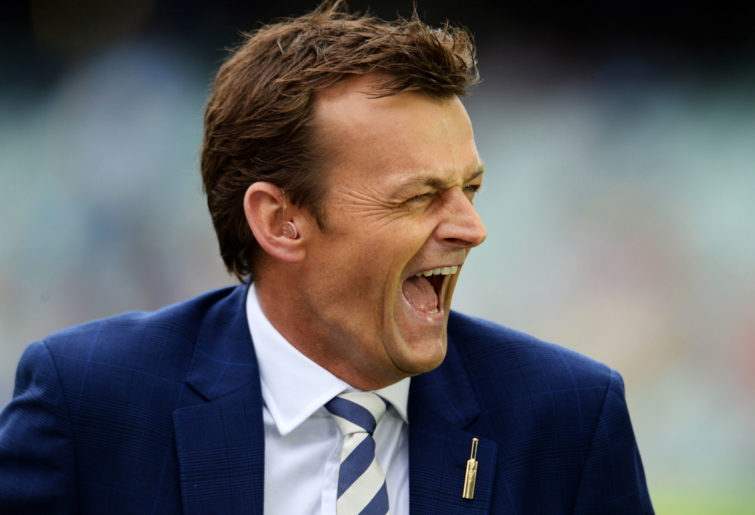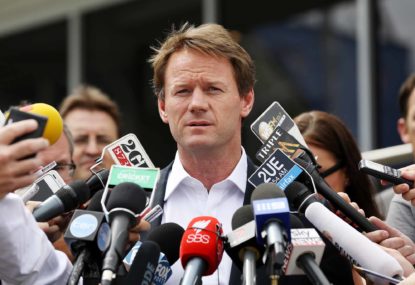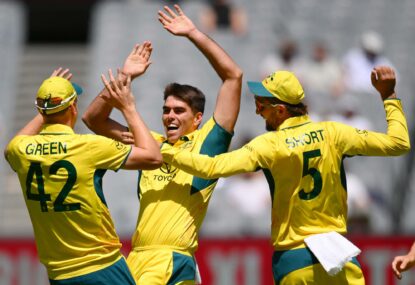Recent times have seen seemingly endless commentary and posturing around high profile goings on in the boardrooms of Australian sport. Cricket Australia (CA) and Football Federation Australia (FFA) have been particularly prominent in the news for their off-field deliberations.
It is unlikely that a board will stay the same for long periods of time, and this is normal. Retirement, personal reasons, compulsory rotation, and scandal – these are just a few reasons why the make-up of a board will change. When replacing board members, it is important to understand where the organisation is in its life cycle, and why the vacancy has appeared.
For example, if the NSO is travelling smoothly, with bumper TV rights deals and positive on-field performances, an outgoing director who is departing due to a legislated time-based rotational change is likely to be replaced with a like-for-like style appointment.
Whilst not particularly forward thinking or innovative, this ‘safe pair of hands’ approach is understandable and, on the face it, difficult to argue with.
The situation is somewhat more complicated though in the case where there has been significant unrest or upheaval in an organisation, as per recent events in Jolimont and Darlinghurst.
Without purporting to examine those examples in depth individually, suffice it to say – for the purposes of this article – that question marks have been raised about the levels of performance offered by previous board members. This situation leads to considerably more discussion than usual, both by industry insiders and the public alike, when contemplating their replacements.
Let us then broadly consider a few of the most common categories of people suggested as possible board members of a large NSO, along with their merits and flaws.
The corporate heavyweight
A popular choice, especially as chairperson, as they convey a sense of security and reliability to the public. They also corporate partners who want to know that whilst they are enjoying the corporate hospitality, they would also like to know that their money is being spent wisely and not just frittered away on champagne and salmon canapés.
Questions arise in this category around the extent to which these people are able to commit to what is actually a pretty full-on role. It is often suggested that those who are still working heavily in another business would be hard pressed to have their finger on the pulse of two quite different worlds at once.
Corporate leaders are also soft targets for the press and public when things go wrong, and lend themselves to lazily critical articles along the lines of ‘Greedy Bureaucrats Fill Their Coffers Despite On-Field Woes’.
Such stereotypes should be avoided though. It is easy and wrong to overlook the genuinely impressive skill-set that proven business leaders can bring to sport – objectivity and a wider exposure to industries other than sport are just a few of the crucial skills that a well-credentialed outsider can bring.
The key here is to appoint someone who is genuinely passionate about the sport and motivated to move the sport forward, not just pad out their CV and impress their mates.
The ex-player and the pundit
Who doesn’t love an old fan favourite? These appointments represent the populist vote, and are tabloid fodder for the back page writers looking to fill lowbrow column inches.
They bring with them knowledge of the game and an understanding of elite performance. Most importantly to some, they also bring an element of recognisability with the public, and the critical ‘common touch’ so often lacking amongst professional administrators.
However, these candidates are fraught with issues and come with a very large ‘buyer beware’ notice.
Ex-players are very often also paid pundits. This creates a very strong conflict of interests on a number of fronts. Mark Taylor, quite rightly, had to rule himself out of board discussions at CA around the new TV rights deal due to his role with Channel 7.
Whilst this was no doubt the prudent course of action, it raises the question of the value of a board member who cannot contribute to a debate affecting a fundamental aspect of the organisation.
Furthermore, their roles as public commentators will seemingly, and inevitably, see them at odds eventually with the governing body as a dissenting personal view slips out under scrutiny.
Turning to soccer, we see Craig Foster as a vocal and active campaigner for a spot on the new FFA board. Respected far and wide for his footballing and administrative pedigree and intellect, he also happens to be the key football anchor and lead commentator on SBS’ football coverage.
Given that, in the past, he has offered lengthy, and sometimes very critical, analysis of FFA’s performance in the areas of governance, expansion and national team performance to name just a few, it is hard to see how he could perform both roles objectively and effectively.
Indeed, this is apparently why cricketing luminaries Adam Gilchrist and Simon Katich have both ruled themselves out of contention for the current CA board vacancies – the dual roles of administrator and commentator seem to mix as well as oil and water.

Adam Gilchrist doesn’t want to be a board member. (Photo by Philip Brown/Getty Images)
Appointing people from this background, without any additional business experience or qualifications, to chair roles is even more worrying – the ability to play a textbook cover drive or execute a well-timed volley does not qualify you to chair the board of an organization with hundreds of millions of dollars in revenue. To suggest otherwise seems nonsensical.
The philanthropist
These characters can be manna from heaven for sports, combining a passion for sport without the pesky need for any real return on investment.
The impression is of a man or woman of the people throwing off the shackles of their weekday suit to join the massed throngs for a weekend drink and cheer along their beloved team.
However, they do bring with them the awkward habit of often wanting to control things. Think Frank Lowy.
Football in Australia owes its very existence since the NSL’s demise to his passion for the game, and specifically to his money, whether out of his considerable personal fortune, or via his Westfield corporate vehicle.
But that kind of investment rarely comes without strings attached, and it was these very strings that saw his son, Steven, controversially appointed as his successor to the FFA chair, which caused the current spill in football’s governing body. No such thing as a free lunch, it seems.
The celebrity fan
A peculiarly American trend (though not exclusively so), these can be potentially galvanizing, or potentially divisive.
More commonly seen in the club environment than the national team arena (e.g. Russell Crowe – South Sydney Rabbitohs, George Calombaris – Melbourne Victory, Jack Nicholson – LA Lakers, Silvio Berlusconi – AC Milan), these celebrities often bring an additional welcome focus to the sport.
Until it is unwelcome. That time can come very suddenly when off-field misdemeanours come to the fore (think a #MeToo moment, or a late night indiscretion snapped by lurking paparazzo).

Russell Crowe in 2014. (AAP Image/Paul Miller)
Their ability to contribute meaningfully to particularly vexing governance issues need to be considered when being thought of as potential board members, and balanced with the potential PR upside.
It is hard to think of Crazy Jack dealing in an officious, cool manner about how to handle Deflate-Gate or something similar (imagine him fronting the NFL commission, frothing at the mouth screaming “You Can’t Handle The Truth!!”).
The faceless ones
The least popular, but often the most effective appointment. Often from a tax, accounting or legal background, these people do the grunt work behind the scenes, chairing Advisory Committees on finance, compliance and other unglamorous portfolios.
These functions really strike at the heart of what boards are there for – it’s not just the breathy adrenaline-fuelled press conferences after a trophy win, or the proud announcement of a new CEO or coach (which are actually quite infrequent and often outsourced to external recruitment consultants anyway).
No, the bread and butter of a board is to ensure that a strategic direction is agreed upon, and executed in a timely manner, in line with any regulatory requirements. Boring, eh?
The ideal board
It probably doesn’t exist. Life isn’t perfect, neither are companies, so the logical extension is that boards are no different. Even if it does exist, in a month’s time someone will resign, and it will be imperfect again.
However, there are some things we do can deduce from a not-so-forensic look at a few commonly raised board concepts.
Do you really need to have played Test cricket, or for the Socceroos, to have sporting credibility as an NSO board member at CA or FFA? It seems rather naïve to think so.
In cricket, are hugely experienced and respected figures such as Brian Johnston, Henry Blofeld, Lawrence Booth or Gideon Haigh less of an expert because they never wore a national team cap?
Is their ability to contribute to the conversation and direction around the game somehow lessened because they have inferior hand-eye coordination to an international cricketer?
Alex Ferguson never represented Scotland at full international; Arsene Wenger’s playing career was so embryonic when it finished you could’ve missed it entirely; and Jose ‘The Special One’ Mourinho was a translator, not a player, before moving into coaching.
Sure, an affinity, understanding and passion for the sport are very important, but it seems odd that so much weight is put on having people ‘from’ the sport on these boards. when so much of board activity is geared around non-sporting matters.
High-performance units abound inside NSO’s these days – if specialist technical knowledge is required at board level for some reason, these teams are perfectly capable of preparing the necessary report for the board to consider without having someone with that expertise actually on the board.
The academic paper “Board Involvement in Strategy: addressing the Governance of Sport Organizations (Ferkins, Shilbury, McDonald – Journal of Sports Management, Vol 23, Iss 3, 2003) examines various models and examples of governance inside sporting bodies.
It concludes that for an organizational strategy to be genuinely effective, the board themselves need to work very closely with the CEO and other members of the executive team.
This does not mean signing off on a strategy during a monthly meeting as agenda item number fourteen. Rather, it means spending significant time working in the business, alongside these paid employees. Only after this level of input and deep understanding, the authors surmise, can really substantial insights and subsequent meaningful effective execution occur.
Another pitfall to be wary of, especially in a time of turbulence or significant board change, is a knee-jerk over-reaction to crisis. Just because there has been a problem within a particular organization, this does not automatically render every single board member redundant or incompetent.
It is important that boards retain corporate memory and context, and a kneejerk mass culling significantly erodes this valuable intellectual property.
If a particular aspect of governance has gone awry, such as finance or risk, then it stands to reason that someone may have to be held accountable for that.
CEO’s and chairs expose themselves to scrutiny when they accept such appointments, and often bear the brunt of any bloodletting that is deemed necessary. The price for this high profile and remuneration is often harsh, as the likes of Ian Robson and James Sutherland can attest to.
And what of gender diversity at board level? Still woefully under-represented inside NSO’s, the introduction of capable females would not only add a much needed different perspective to decision-making, but also go some way towards breaking down barriers to participation that exist in some male-dominated sports.
Indeed, Sport Australia sets out 40 per cent as the minimum female representation it sees as acceptable at board level.
This is not always as easy as it sounds though, as some traditional sports struggle to attract passionate, interested and qualified women who actually want to be involved in these organizations.
Female appointments at board levels in NSO’s often seem limited to ex-players. This not a wide enough net to cast, as the criticism of ex-male players as board members are equally valid when aimed at women (e.g. lack of experience outside the narrow sphere of the game itself).
All NSO’s need to tread a fine line here between tokenism and genuine appointments, as any hint of weakness or nepotism will be magnified if an unprepared female appointee is exposed to the circling dinosaurs who lurk in the shadows, ready with a snide ‘I told you so’.
There will be some window-dressing. It’s ok to have a few high-profile board members who provide comfort to the public, as long as they know their limitations and don’t profess to be the only person who can add value around the boardroom table.
The public face of the board needs to be eloquent and visible. Grey men in suits just won’t cut it anymore.
It is naïve to think that those with strong corporate contacts, the ability to attract financial partners and speak the language of money are not still essential to the effective operation of an NSO. With revenues in the hundreds of millions of dollars, the business of sport is just that – a business.
No longer are boards solely discussing operational issues such as rogue behaviour, or the under-performance of representative teams.
A modern NSO board needs members with a blend of charisma, vision, hard-nosed business skills and relevant experience who are not afraid to tell less and ask more.
Such a mix is not easy to achieve, which is why those with the power to influence the make-up of a board have the considerable responsibility of wielding that power only after very careful deliberation.
This means selecting members based on current needs and best fit for the board, not being dragged into a public beauty contest, and looking beyond personal and parochial agendas.
Cathy Trower, President of Trower & Trower Inc., a board governance consulting firm, states the following opinion in relation to the make-up of a board;
“The best boards are those in which the sum adds up to more than the individual parts. Boards operate as collectives of individuals.”
Similarly, the New Zealand Institute of Directors suggests that;
“A board that truly adds value is not just a group of high performing individuals. A good board is a balanced team with complementary skill sets and a culture that allows them to work together to make the most effective decisions for an organization.
“While the leadership from the chair is crucial, it is the full participation of every board member that contributes the most to the effectiveness of a board.”
It is through this lens that we should judge the upcoming raft of board appointments in Australian sport – that is, where do they fit into the overall big jigsaw and what is their specific role, as opposed to simply looking at an individual in isolation
In summary, these are the key considerations to be assessed when appointing new board members.
Why has the vacancy arisen – where is your skill set gap?
Natural attrition or performance? This affects whether you are looking for a straight swap or a changeup in expertise.
Where is the organization in its life cycle?
As per CEO’s, different board members are required depending on needs at the time – e.g. revenue generation, governance reform, pathway development, government relationships, public appeasement.
Are there any conflicts of interest?
These organizations are large and the issues complicated enough as it is without adding a further layer of complexity through appointing those with conflicts of interest, whether perceived or real.
Remove the conflict, and remove the problem.
Are you meeting Sport Australia’s guidelines on board governance?
Whilst not absolutely essential to do so, funding may suffer as a result of non-compliance. Female quotas in particular need to be considered.
The Sniff Test!
If you can imagine yourself struggling to explain your appointment without floundering for the right words and rolling out clichés and platitudes because you know you’ve appointed a mate, or made a soft decision – STOP.
If you can’t convince yourself, then the public and media will see through you very quickly – scrutiny levels today are such that ‘donkey’ appointments just will not wash.







































































































